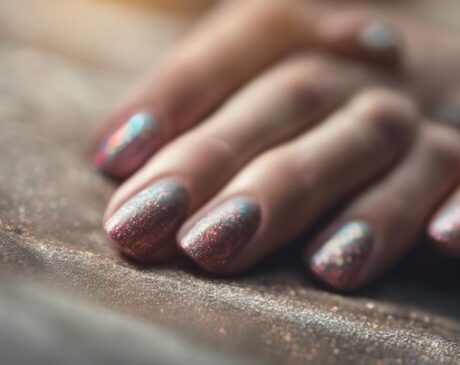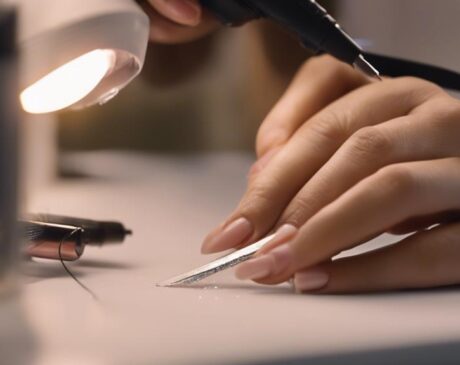Should You File Your Nails Before Applying Press Ons?
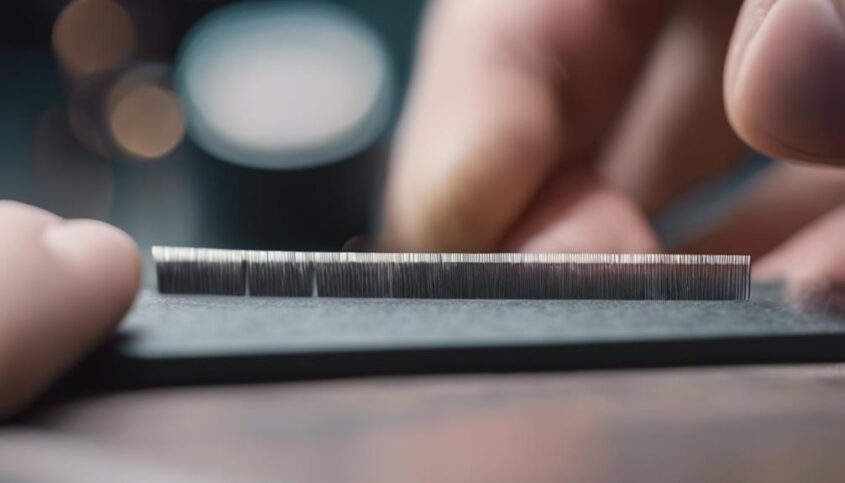
Filing your nails before applying press-ons is crucial for a smooth, durable finish with optimal adhesion. It ensures a clean canvas for better bonding, prolongs the wear of artificial nails, and aids in shaping and sizing press-ons accurately. Proper techniques like filing in one direction and holding the file at a slight angle are essential. Consider nail shape and length to enhance the appearance before application. Remember, these practices help in maximizing the adhesion for a long-lasting manicure.
Key Takeaways
- Filing nails ensures smooth surface for press-ons to adhere properly.
- Proper filing enhances longevity and adhesion of artificial nails.
- Nail filing creates a clean canvas for press-ons to bond effectively.
- Secure bond between natural nails and press-ons is promoted by filing.
- Filing allows for better shaping and sizing of press-ons for comfortable wear.
Benefits of Filing Nails for Press-Ons
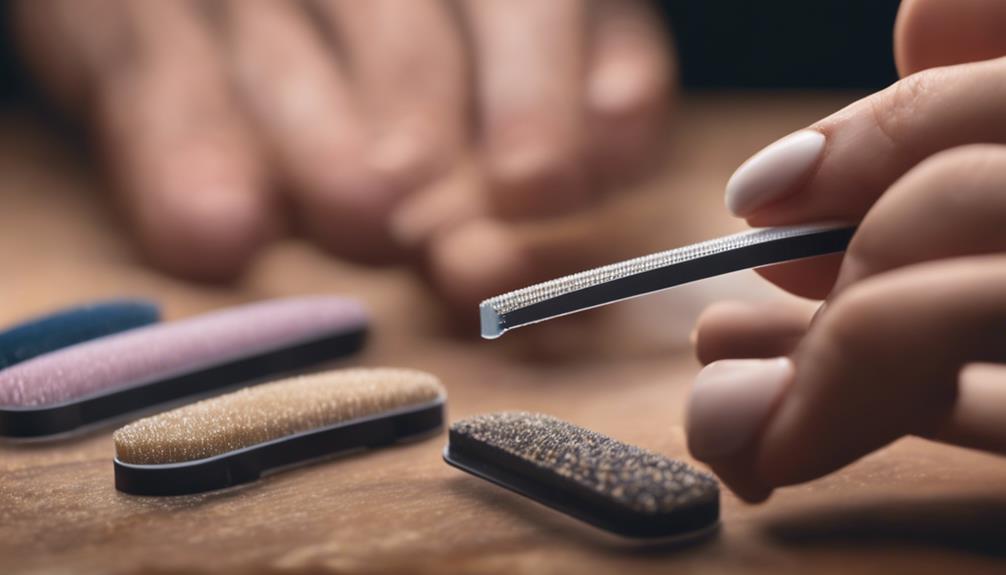
Filing nails before applying press-ons ensures a smooth and even surface for optimal adhesion and longevity of the artificial nails. This crucial step creates a clean canvas for the press-ons to adhere to, reducing the risk of air bubbles or lifting. By filing the natural nail to remove any rough edges or uneven surfaces, the press-ons can sit flush against the nail bed, providing a seamless and professional finish.
Properly filed nails also promote a more secure bond between the press-ons and the natural nail, preventing premature detachment or breakage. When the nail surface is smooth, the adhesive on the press-ons can adhere evenly, maximizing the lifespan of the artificial nails. Additionally, filing the nails beforehand allows for better shaping and sizing of the press-ons, ensuring a comfortable fit that enhances the overall look and feel.
Innovative techniques in nail preparation, such as filing before applying press-ons, are essential for achieving salon-quality results at home. This simple yet effective practice sets the foundation for flawless and long-lasting artificial nails that stay put and look impeccable.
How to Properly File Nails
To properly file nails, it is essential to understand the basics of nail filing, including the importance of choosing the right tool and mastering the technique for achieving smoothness. Nail filing basics involve knowing how to shape nails without causing damage, while selecting the correct tool ensures an effective filing process. Additionally, mastering the technique for smoothness involves using gentle, consistent strokes to achieve the desired nail shape without rough edges.
Nail Filing Basics
Proper nail filing technique involves gently shaping the nails in a consistent direction to prevent splitting and maintain a smooth edge. To begin, use a high-quality nail file with a fine grit to avoid rough edges. Start by filing in one direction rather than back and forth, as this helps to prevent nail damage. Hold the file at a slight angle to the nail edge for a more natural shape. Work slowly and deliberately, checking the nail's shape frequently to ensure symmetry. Avoid filing too aggressively, as this can weaken the nails. Remember, the goal is to achieve a balanced and smooth nail edge that serves as the perfect canvas for applying press-on nails.
Choosing the Right Tool
When selecting the appropriate tool for nail filing, it is essential to consider the grit level of the file to ensure a smooth and precise shaping process. The grit level refers to the coarseness of the file's surface, with lower grit numbers indicating a rougher texture for shaping acrylic or hard gel nails, while higher grit numbers provide a finer surface suitable for natural nails. Opting for a file with a grit level between 180 to 240 is ideal for shaping natural nails without causing damage. Additionally, choosing a file made from high-quality materials such as crystal, glass, or metal can enhance durability and performance, resulting in a more efficient and effective nail filing experience.
Technique for Smoothness
For optimal results in achieving smooth nails, mastering the correct filing technique is crucial. Begin by selecting a high-quality nail file with a fine grit to prevent rough edges. When filing, move the file in one direction instead of back and forth to prevent nail layers from peeling. Start at the outer edge of the nail and shape towards the center, following the natural curve of your nail. Avoid using excessive force, as gentle and consistent strokes yield the best results. Aim for a rounded or slightly squared shape to minimize the risk of breakage. Remember, precision is key when filing nails for a flawless finish before applying press-ons.
Tips for Nail Shape and Length
Achieving the ideal nail shape and length is crucial for ensuring a polished and lasting look when applying press-on nails. When it comes to nail shape, opting for a style that complements your fingers can enhance the overall aesthetic of your manicure. Consider trendy shapes like almond, coffin, or stiletto for a modern appeal, or stick to classic options such as square or oval for a timeless look. The length of your nails is equally important, as it can impact how well the press-on nails adhere and how comfortable they feel. Longer nails provide more surface area for the press-ons to bond with, while shorter nails may offer a more practical and manageable length for daily activities. Ultimately, choosing a nail shape and length that align with your personal style and preferences will contribute to a seamless and stylish press-on nail application.
Enhancing Adhesive Bonding
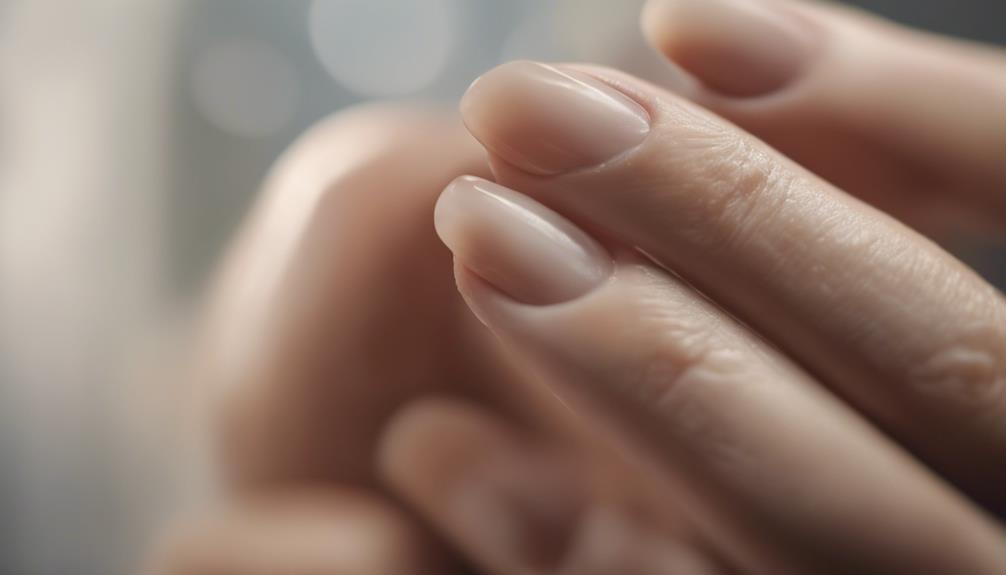
To optimize the longevity and durability of press-on nails, ensuring a strong adhesive bonding is essential. Enhancing adhesive bonding is a critical step in achieving a flawless and long-lasting manicure. One innovative way to enhance adhesive bonding is to thoroughly cleanse the natural nails before application. This removes any oils or residues that could hinder the adhesive from sticking effectively. Additionally, using a primer specifically designed for press-on nails can significantly improve the bond between the natural nail and the artificial nail. These primers create a surface that promotes better adhesion, ensuring that the press-on nails stay in place for an extended period. Another technique to enhance adhesive bonding is to gently roughen the surface of the natural nail using a buffer. This creates a slightly textured surface that allows the adhesive to grip onto the nail more effectively, reducing the chances of the press-on nails lifting or popping off prematurely. By implementing these innovative methods, you can maximize the adhesion of press-on nails, resulting in a flawless and long-lasting manicure.
Avoiding Nail Damage
To maintain the health and integrity of your natural nails while wearing press-on nails, it is important to take preventative measures against nail damage. One way to avoid nail damage is by ensuring that you properly prepare your natural nails before applying press-ons. This includes gently pushing back your cuticles and avoiding cutting them too aggressively, as this can lead to nail weakening and breakage. Additionally, it is crucial to avoid over-filing your nails, as this can make them more susceptible to damage and breakage.
To further prevent nail damage, it is essential to choose high-quality press-on nails that fit your nail beds properly. Ill-fitting nails can cause unnecessary pressure on your natural nails, leading to potential damage and discomfort. Lastly, be mindful of how you remove your press-on nails. Using gentle techniques and products specifically designed for easy removal can help minimize any harm to your natural nails.
| Preventative Measures | Description | Benefits |
|---|---|---|
| Proper Cuticle Care | Gently push back cuticles | Prevents nail weakening |
| Avoid Over-Filing | File nails gently | Reduces susceptibility to breakage |
| Choose Properly Fitting Press-Ons | Ensure nails fit well | Prevents pressure and damage |
| Gentle Removal Techniques | Use products for easy removal | Minimizes harm to natural nails |
Improving Press-Ons Appearance
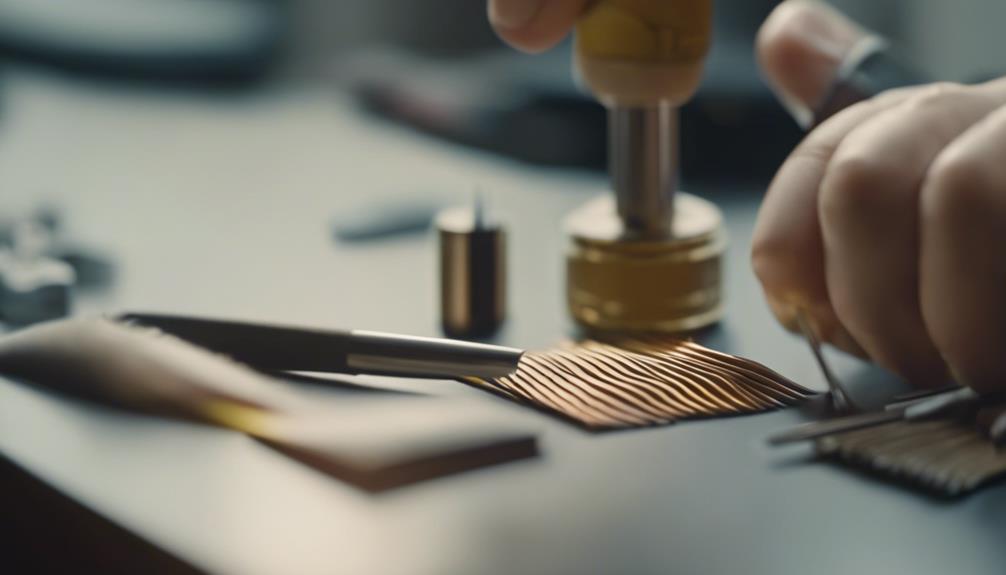
Enhancing the aesthetic appeal of press-on nails can be achieved through strategic nail art application techniques. To elevate the appearance of press-ons, consider incorporating trendy designs such as ombre gradients, geometric patterns, or minimalist nail art. Experimenting with different textures like matte, glossy, or textured finishes can also enhance the overall look. Additionally, utilizing embellishments such as rhinestones, studs, or decals can add a touch of glamour to your press-on nails.
Furthermore, playing with color combinations and negative space can create visually stunning effects. For a more personalized touch, try customizing your press-ons with initials, symbols, or meaningful designs. Don't shy away from exploring unconventional shapes or nail lengths to make a bold statement.
Innovative techniques like using nail stamping plates, nail vinyls, or freehand painting can take your press-on nails to the next level. By experimenting with different artistic approaches and staying up-to-date with nail trends, you can achieve a polished and fashion-forward look that will make your press-ons stand out.
Longevity of Press-Ons
Achieving extended wear with press-on nails involves considering the impact of nail length, evaluating the adhesive strength required, and mastering the correct application technique. By understanding how these factors influence the longevity of press-ons, individuals can enhance the durability and overall performance of their artificial nails. Paying attention to these key points will help users make informed decisions to maintain the longevity of their press-on nails.
Nail Length Impact
The length of your natural nails significantly influences how long press-on nails will last. Longer natural nails provide a larger surface area for the press-ons to adhere to, offering better stability and longevity. When natural nails are shorter, there is less contact between the press-ons and the nail bed, which may reduce the overall adhesive strength and lead to a shorter wear time. To optimize the lifespan of your press-on nails, consider maintaining a slightly longer length on your natural nails. This simple adjustment can enhance the bond between your natural nails and the press-ons, ensuring a more secure and durable wear, ultimately allowing you to enjoy your flawless manicure for an extended period.
Adhesive Strength Consideration
Considering the impact of natural nail length on the longevity of press-on nails, it is imperative to evaluate the adhesive strength as a key factor in determining the overall durability of the manicure. The adhesive strength of press-on nails plays a crucial role in ensuring a long-lasting and secure bond between the artificial nails and the natural nail bed. High-quality adhesives with superior bonding properties can significantly extend the wear time of press-on nails, allowing for a flawless and lasting manicure. Innovations in adhesive technology have led to formulas that offer enhanced strength and longevity, providing users with a reliable and durable nail enhancement solution. When selecting press-on nails, it is essential to consider the adhesive strength to achieve optimal results and maximize the longevity of the manicure.
Application Technique Importance
For optimal longevity of press-on nails, the application technique plays a crucial role in ensuring a secure and lasting bond between the artificial nails and the natural nail bed. Proper preparation of the natural nails by cleaning, buffing, and applying a primer can enhance adhesion. When applying the press-ons, it is essential to press firmly and hold each nail in place for a few seconds to allow the adhesive to set properly. Additionally, ensuring that there are no air bubbles trapped underneath the press-ons can prevent premature lifting. Following these precise application steps can significantly increase the lifespan of press-on nails, providing a seamless and durable manicure that lasts longer and looks professionally done.
Frequently Asked Questions
Can I Use a Nail Clipper Instead of a File to Prep My Nails for Press-Ons?
When prepping nails for press-ons, a nail clipper may seem like a quick fix, but using a file offers precision and smooth edges vital for a flawless application. Embrace innovation – choose the file!
How Often Should I File My Nails When Wearing Press-Ons?
Regular filing when wearing press-ons is crucial for maintaining nail health and ensuring optimal adhesion of the artificial nails. Aim to file your nails every 7-10 days to prevent lifting and promote longevity of the press-ons.
Will Filing My Nails Make Them Weaker or More Prone to Breakage?
Filing nails can remove microscopic layers, potentially weakening them. However, proper technique and gentle filing should not significantly increase nail breakage. Balancing maintenance with nail health is key when considering filing frequency before applying press-ons for optimal results.
Are There Specific Nail File Types or Grits That Are Best for Prepping Nails for Press-Ons?
When prepping nails for press-ons, opt for a medium-grit nail file to gently shape and smooth the nail surface. Avoid metal files that can cause damage. A 180-240 grit file is ideal for creating a suitable canvas for flawless press-on application.
Can I Apply Press-Ons Directly Onto Unfiled Nails for a Quicker Application Process?
For a seamless and long-lasting application, it is recommended to file your nails before applying press-ons. This step ensures a smooth surface for better adhesion. Taking this extra step can enhance the overall look and durability of your press-on nails.

